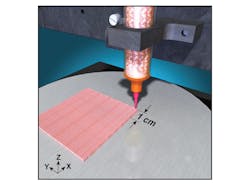Researchers at Lawrence Livermore National Laboratory (LLNL) have for the first time 3D printed composite silicone materials that are flexible, stretchable, and possess shape memory behavior. This discovery that could lead to form-fitting cushioning activated by body heat, such as in helmets or shoes.
The researchers added hollow, gas-filled “micro-balloons” into silicone-based ink, letting them 3D print devices at elevated temperatures that then shrink when it cool. When reheated, the gas in the micro-balloons expands, causing the structure to return to its original shape. When combined with 3D printing, this shape memory behavior is often referred to as “4D printing,” with the fourth dimension being time.
“The impressive part was how well the structures could recovered their shape after being reheated,” says LLNL researcher Amanda Wu. “We didn’t see distorted structures; we saw fully recovered structures. Because the silicone network is completely crosslinked, it holds the part together, so the structure recovers its original shape in a predictable, repeatable way.”
The researchers printed their silicone-based samples using a direct-ink-writing process. The composite ink material was extruded at room temperature from the printer’s nozzle to form woodpile-like structures with controlled porosity and architecture.
The researchers accidently discovered the material while attempting to engineer a hierarchical porous material that would completely recover after being compressed under heat, exhibiting what is known as zero compression set. Instead, they got the opposite result. Undeterred, LLNL scientists wondered what would happen if they reheated the structures, thinking the gas trapped in the material would cause it to re-expand—and it did.
The key to the shape memory behavior is the polymer micro-balloons embedded in the silicone ink. The thin polymeric shell in the micro-balloon has a glass transition temperature. Below that temperature, the shell is rigid and glassy; above that temperature, the shell becomes soft and malleable. Therefore, by heating the composite material above the shell glass-transition temperature, the spheres’ polymer shells soften. This allows them to be compressed, altering their shape; they then stay deformed and resist re-expansion of the silicone matrix when cooled. When reheated, the balloons expand, and the restoring force of the heated gas and silicone force the structure to recover its original contour.
One challenge to the project was coming up with inks that could incorporate the micro-balloons but wouldn’t jam the 3D printer’s nozzle, and then heating and compressing and cooling the printed samples to set their shape.
The researchers printed their samples using a direct-ink writing process in which the composite ink material was extruded at room temperature from the printer’s nozzle to form woodpile-like structures with controlled porosity and architecture. By being able to 3D print the material, it became more lightweight and functional, and the researchers could exert greater control over its overall 3D geometry and composition.
What’s unique about their approach, the researchers said, is that the shape memory component is engineered into the material, so the micro-balloons could be used to add shape memory into any polymeric base material, including stretchable materials such as elastomers.
“Historically, shape memory polymers tend to be rigid,” notes materials scientist Eric Duoss, an investigator on the project. “By incorporating micro-balloons into a rubbery matrix, we’ve created a composite that is soft and stretchy—even below the glass transition temperature of the micro-balloons, which is a shape memory material with previously unattainable qualities.”
Lab researchers have filed a patent application for the material. Because it can be 3D printed into an arbitrary net shape and made into a highly porous structure with both open and closed cells, researchers said it might be useful for thermally activated cushioning that is highly tunable and customizable. For example, by modulating the micro-balloon’s glass transition temperature to be below body temperature, the material could be compressed under heat and cooled, then stored at cooler than body temperature. When worn, it would expand to fit the head in a helmet or a foot in a shoe. If the glass transition temperature is slightly above body temperature, the wearer could heat the material in an oven or pot of warm water, and then customize it fit, similar to the process of form-fitting a mouth guard.
“You could use this for any customized mechanical energy-absorbing material,” Duoss says. “Then, if the wearer grows a little bit and wants to refit the material, they just heat it up to expand it, put it on and let it cool to once again to customize the fit. It’s reversible.
“It’s a completely new material really, and we're excited about it,” he continues. “It’s a material that should have a lot of commercial potential and should be ripe for technology transfer to industry.”
The process could be scaled up to produce much larger parts for packaging and transportation applications, according to the researchers In addition, the material wouldn’t necessarily need to be 3D printed. Micro-balloons could be incorporated into any kind of base material and molded or cast, but the resulting material might not have the same compressibility as 3D-printed porous structures.



